Fermented foods bring more than just increased nutrition to your diet though; They also protect against pathogens and are an awesome way to improve gastrointestinal health.

If you are new to fermented vegetables having a probiotic culture can ensure that the right lacto-bacteria colonizes your fermented vegetables each and every time. But, you don’t need to purchase a live culture to begin your vegetable ferments as you do for yogurt, kefir, and other dairy ferments. Though dairy ferments often consume the lactose making yogurt and kefir good options to help give reduced lactase for those with lactose intolerance who still enjoy dairy.
You’ll find that the lacto-bacteria is already present on the skin of many vegetables like cabbage and kale. If you have a probiotic-rich kitchen that has seen many successful ferments already you may not need any additional help to get the right bacteria in your ferment. It will already be present in the air of your home.
The Benefit of Fermented Foods
- Increase nutrition
- Increase digestion and absorption of nutrients
- Weight loss
- Increase in B vitamins, including B-12
- Increase Omega-3 fatty acids
- Supports immune function
- Increased digestive enzymes
- Supports healthy gut microbiota
- Increased probiotics like lactase and lactic acid, and other immune chemicals that fight off harmful bacteria and even cancer cells.
Investing in a starter culture can prevent unwanted bacteria from colonizing your ferment prematurely before the right lacto-bacteria takes hold. Get ideas to bring live cultures into your kitchen by discovering these six ways to get live culture for your fermented vegetables.
Bread and Butter Pickles
It is Easier to make fermented pickles with the right tools. Now, instead of a full batch of vinegar pickles that need to be canned in a boiling water bath, I ferment my pickles one jar at a time. Fermented pickles allow you to pickle just a quart or two each week. In fact, it couldn’t be easier if you have a few pickling cucumber plants, to do a quart of fermented dills each week. Get tips for no-fail Lacto-Fermented Vegetables.
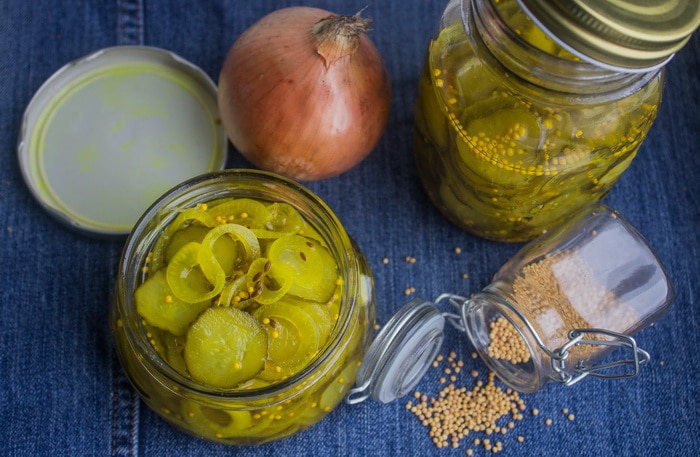
jar of fermented pickles
Fermented Vegetables for Gut Health
Fermented foods bring more than just increased nutrition to your diet though; They also protect against pathogens and helps digestion. In fact, eating fermented foods can help you lose weight, lower blood pressure, heal your gut, lift depression, clear your mind, and maybe prevent cancer
Culturing your own vegetables at home is quick and easy. You can have the jar fermenting on your kitchen counter in less than 15 minutes of prep time and have fermented veggies ready to eat in as little as 5 days. Fermenting vegetables is also a great way to help make vitamin K more bio available too. But if you don`t have any cultured vegetables in your fridge, where do you begin? Try one of these recipes.
How to Make Raw Sauerkraut and Fermented Vegetables
Once these beauties are finished, you can store the jar in your refrigerator to eat right away or you can store it in a cool dry place, like your root cellar. Fermented vegetables need no further processing. I’ve kept jars of sauerkraut in my fridge for a year and served out of them throughout the year. They are kept preserved by the lacto bacteria in them.
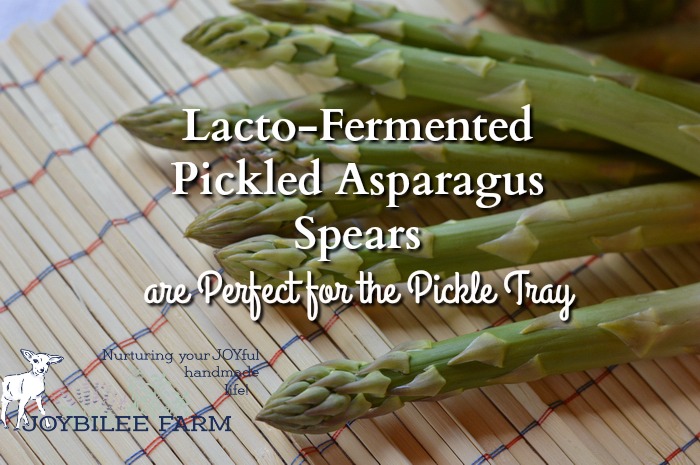
Lacto-Fermented Pickled Asparagus Spears are Perfect for the Pickle Tray
The asparagus season is short but once your asparagus garden gets going, the harvest can be prolific. You can eat it as you harvest it, freeze it for winter, or preserve it by pickling. Lacto-fermented pickled asparagus preserves the crispness of raw asparagus with a tangy, slightly sour flavor that makes it a star on the pickle tray.
Easiest Fermented Carrot Sticks That the Whole Family Will Love
Here is the easiest way I know to get fermented veggies on the menu whether in a lunch box or in a pickle dish. Fermented carrots only take 4 days to finish fermenting in the average warm kitchen. They are only slightly sour. You can make them plain with just carrots and salt. But they are also a great palette for other flavors like dill, fennel, lemon or orange peel or something stronger like garlic. If it’s your first try at fermented vegetables you can’t go wrong with carrots.
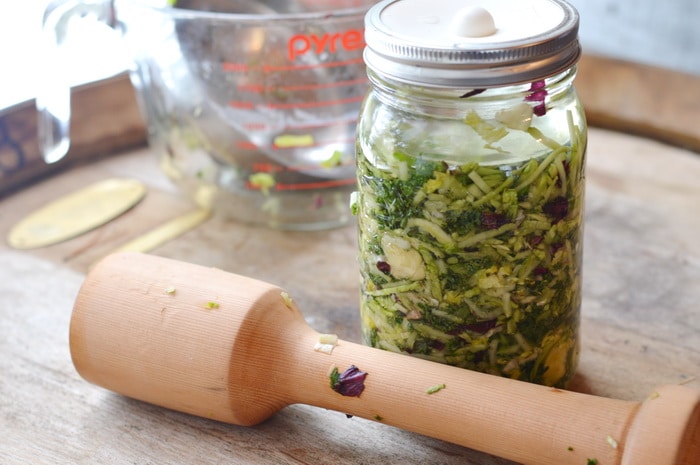
Fermented Cabbage – The Fastest and Easiest Sauerkraut You’ve Ever Made
This sauerkraut is literally the fastest sauerkraut you will ever make. No need for hours of slicing the cabbage leaves. No heavy pottery crocks to scald and sanitize. And it’s ready in just a week when you make it in a one-quart jar. So if you’ve been procrastinating getting fresh sauerkraut brewing on your counter in the middle of winter; if you’re just too busy to take a cabbage and slice it up; if you have too many commitments to spend an extra hour in the kitchen; or if the $20 a quart price on raw sauerkraut isn’t enough motivation to make your own, this recipe will move you to action.
This Easy Kimchi Recipe is Great for First Time Fermenters
Kimchi is fermented cabbage, served as a side dish. It’s a staple in Korean cuisine. It’s made with cabbage (Napa cabbage is common) as the base, seasoned with chilis, garlic, ginger, and scallions, and salted for preservation. Many traditional Asian foods, including tempeh and soy sauce are also fermented with lactic acid bacteria.
How to Make Fermented Vegetables Without Salt
Inoculating a jar of fermenting vegetables with the good microbes will encourage the good microbes to reproduce at a faster rate, crowding out the bad microbes. This replaces some of the need for salt in your recipe. Find out how to do it in this article. Use active cultures, and maybe add apple cider vinegar if you’re worried about the salt-less ferment.
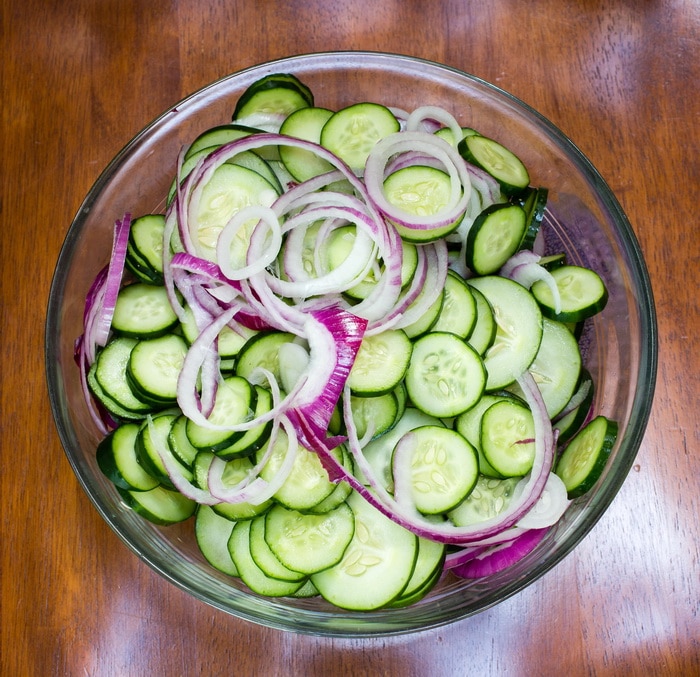
Cucumbers and onions sliced into chips for pickle making.
Sugar-Free Bread and Butter Pickle Recipe That is Ready in a Week
Most bread and butter pickle recipes are high in both sugar and vinegar. Not this sugar-free bread and butter pickle recipe. Bread and Butter pickles are sweet and sour at the same time. That’s what makes them the perfect accompaniment to potato salad, burgers, hot dogs, and sandwiches.
The Best Vegetables to Ferment
- carrots
- beets
- cucumbers
- cabbage
- asparagus
- green beans
- cauliflower
- tomatoes
- sweet and hot peppers
- kale
Lacto fermentation is good for many foods!
Try these ideas for fermenting herbs and other food that you might not initially think about preserving by fermentation. This brings gut health to a new level. Fermented dairy products are also filled with beneficial bacteria, like this yogurt.
2 Ways to Ferment Fresh Herbs to Preserve Them for Months
Fermented fresh herbs have an intensely fresh, tangy taste. Fermenting locks in the flavor and gives them a tangy zing from the lactic acid of the ferment. While you can freeze herbs them for later, fermentation is another preservation method that offers significant benefits both in probiotics, health benefits, and taste.

How to Ferment Grape Leaves and Eat Them in Winter
While your grapevines are at their active growth stage, in midsummer, harvest a few dozen leaves and preserve them for later use. Fermented grape leaves are pliable and flavourful, perfect for wrapping up fillings. If you’ve never tried this often overlooked vegetable, you’ll want to do it this year. You can also include grape leaves in with regular cucumber pickles, at the start of the fermentation process, to improve texture and firmness, as they are a natural source of alum, as is horseradish.
Lacto-fermented Hot Sauce From Garden Fresh Hot Peppers
This fermented hot sauce recipe uses red jalapeño peppers, but you can use whatever hot peppers you have in your garden. Serrano peppers or cayenne peppers will turn up the heat. Use the lacto-fermented hot sauce sparingly as a condiment, since it is flavorful and warming, you can choose how warm to make it.
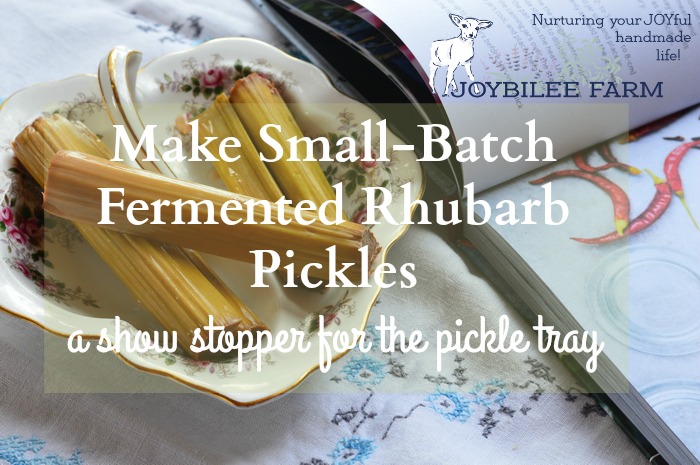
Make Small Batch Fermented Rhubarb Pickles, a Show Stopper on the Pickle Tray
Fermented rhubarb pickles are ready in 5 to 7 days. Leave them for a month and the flavors will merge into a tart-sweet delight. They’ll keep in the fridge for a year, so go ahead and make a few jars while the rhubarb is at its peak of ripeness.
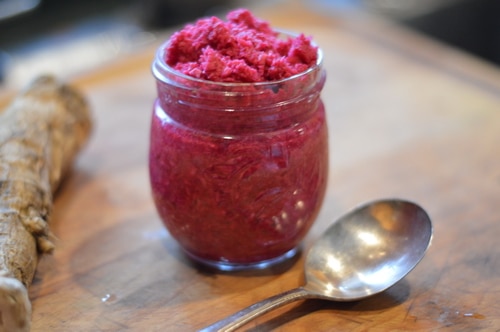
Lacto-fermented horseradish
A condiment that is easy to grow. A little goes a long way. Add lacto-fermentation to the recipe and it improves the flavor of strongly flavored meat and make it easier for you to digest them. Remember that natural ferments shelf life is up to a year, refrigerated. You can can the ferments, but canning will remove the live microorganisms so refrigeration is the best bet.
Fermented Grainy Mustard
Making dijon-type mustard at home is really easy. When you add fermentation you get a healthy condiment that improves the flavor and digestibility of meat and beans. It goes great with cheeses and other dishes.
Make Your Own Super Healing Kombucha Tonic for your Family’s Health
Learning how to make kombucha at home can save you money and increase your family’s health. These easy step by step instructions for how to make Kombucha from a starter culture will help you have a successful batch. This is a great fermented beverage for daily consumption. Kefir grains can also be used to make water kefir, another fun fermented beverage.
The Best Fruits to Ferment – Probiotic Fruits
You know that fruit contains a lot more sugar than vegetables. These sugars are exactly what the microorganisms feast on to produce bacteria, acids, and yeasts in a cultured food product. Because the sugars are so universal in fruit, your fruit fermentation will require closer monitoring than fermented vegetables. Try fruits these for beginners. Add some ginger for a bit of a kick.
- raspberries
- strawberries
- apples
- pears
- fig
- peach
- dates
Easy Peach Mead Recipe with Summer Roses and Elderflowers
This peach mead recipe is easy to make in small batches as the peaches ripen or the roses bloom. Mead is the ideal vehicle for saving summer’s bounty for winter in small batches. Mead is wine sweetened with honey instead of sugar. While you could make mead with only honey and yeast, adding fruit, berries, and herbs to mead recipes offers exciting and limitless possibilities.
Fermented foods will add flavor and increased nutrition to your diet though. Start with a simple sauerkraut or carrot recipe and add spices as your confidence increases.
Fermenting Grains:
A great way to improve the protein availability, and digestibility of grains is through fermentation. Sourdough bread is fermented with yeast, while rye bread is traditionally closer to a sour lacto-bacteria ferment. Both techniques reduce the phytate presence in the grains, improving calcium presence, and improving the digestibility of the grain compounds. Barley flour or whole grain barley can also be fermented, as can rice if desired.
You can even make sourdough pancakes!
Soybeans are also traditionally fermented with lacto bacilli bacteria, and tofu and miso soup are a few of the results of those ferments. Those are mostly done on a commercial scale now, and it is rare for non-fermented soy to be consumed in Asia.
More Delicious Drinks:
For more thirst quenching, healthy drinks that are low on sugar and high on flavor, check out my new class.
Learn more about making healthy and nutritious shrubs, vinegar drinks, ice pops, sherbet, botanical drinks, herbal tea, fruity lemonades, liqueurs, and bistro drinks healthier at home using wholesome ingredients, less sugar, and more fun. My new class Inspiring Botanical Drinks will help you turn your garden produce and easy to find ingredients into beautiful beverages and frozen desserts easily.
Break the pop and sweet tea habit with these healthier options. You’ll save money, reduce food waste, and enjoy delicious and nutritious hot and cold drinks year-round when you use herbs, garden fruit and berries, and even weeds to make healthy tea, drinks, and beverage syrups.
Make the most of your garden harvest AND kick the unhealthy drinks out of your diet with the tips and tricks you’ll learn in my new class.



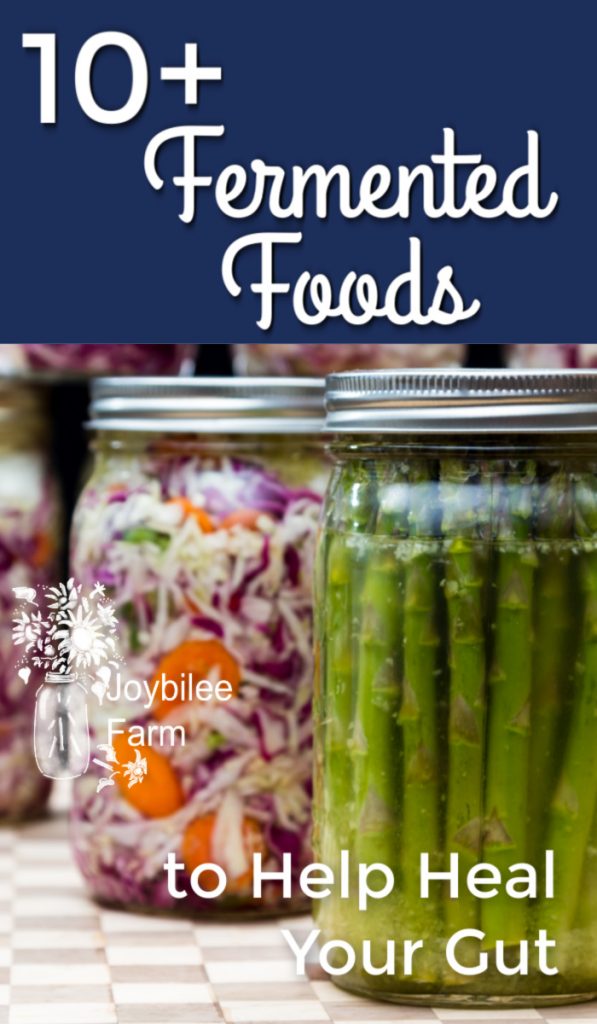
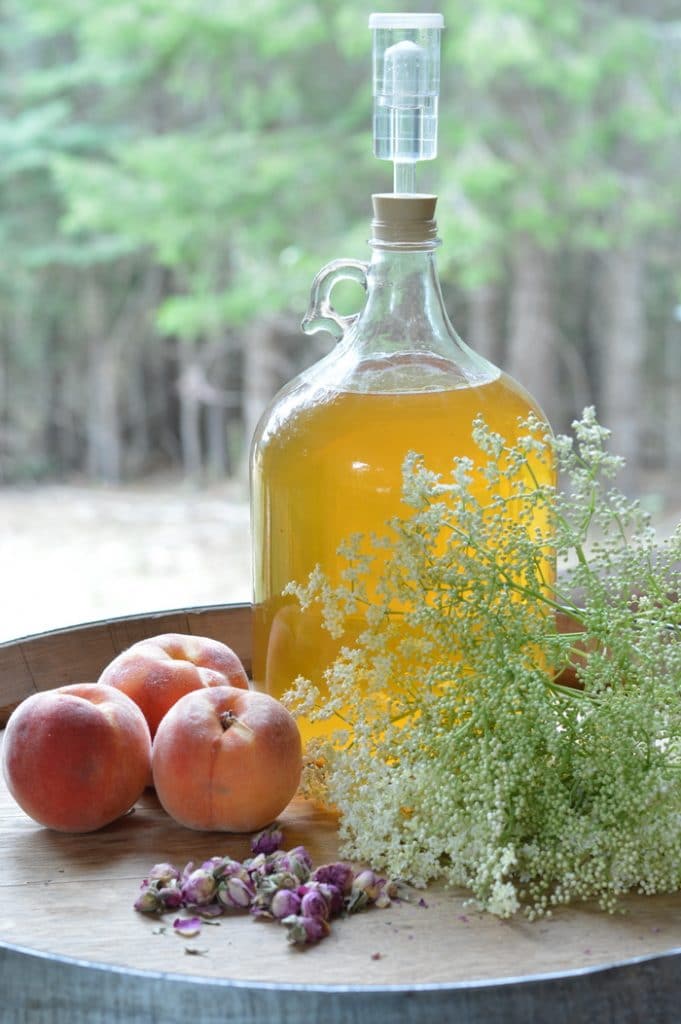
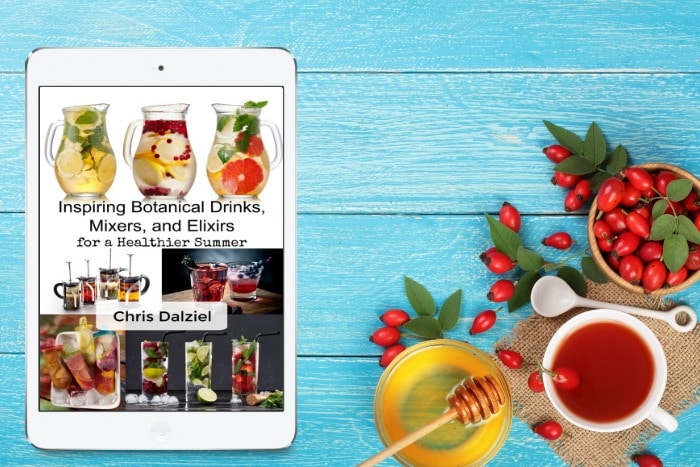


Genius! Now I want a peach fizz.
Hello Chris,
Still love your delicious resourcefulness! For a little over a year we have enjoyed what the grandkids call hooch; fermenting Welches 100% grape juice with Ginger bug . Yes it can taste somewhat like wine if a bottle gets lost in the fridge beyond a few weeks heehee.
Reading this article I slap my forehead …duh, I have a Champion juicer….why am I not juicing fresh fruit (we mostly juice veggies ) for this. My dilemma had been finding organic juice besides cherry that didn’t have sugar or anything else added to it which is why we just stuck with Welche’s. Now that the BC market is abundant with org peaches, grapes , nectarines I will try some small batches vs the gallon at a time!
Congrats on your happy harvesting!